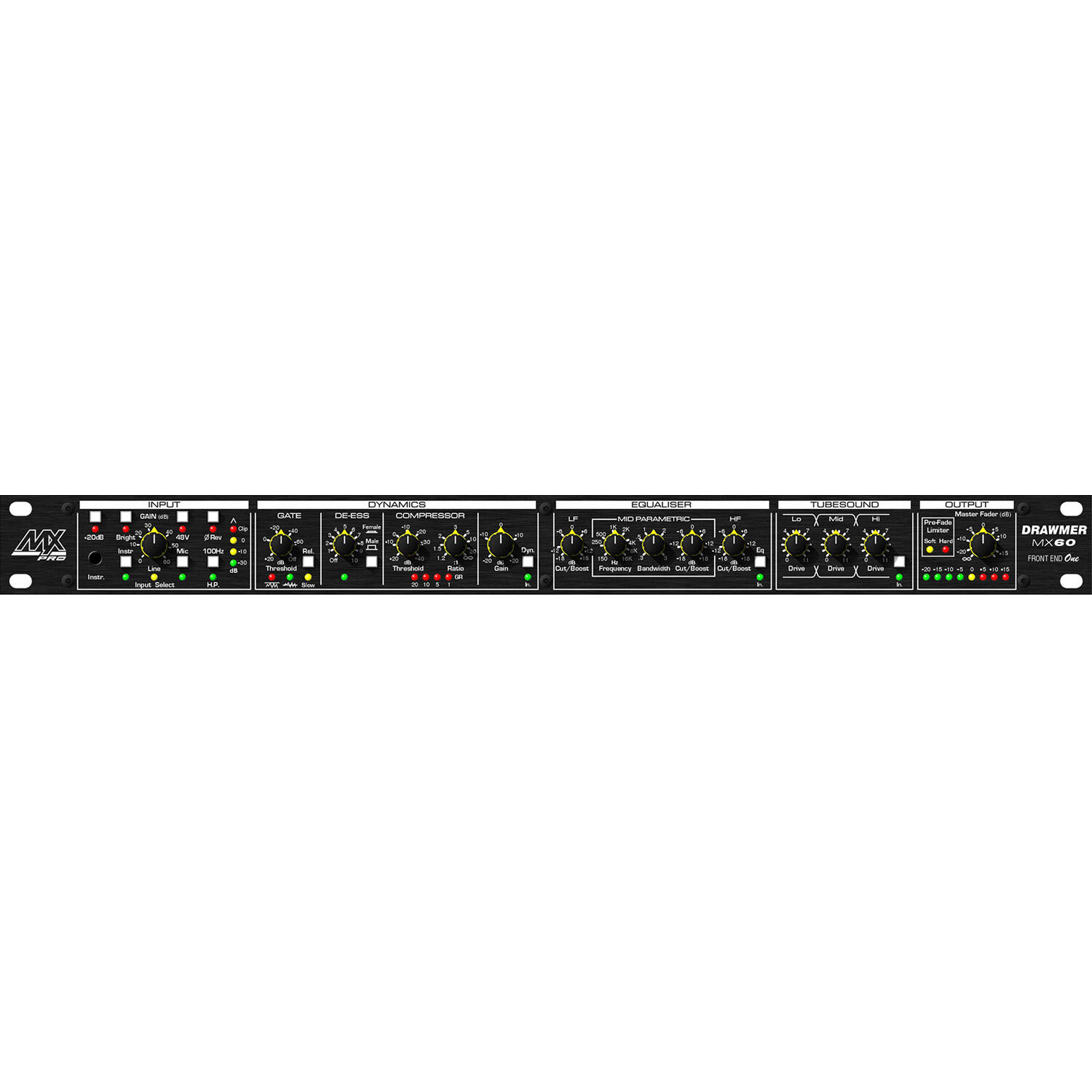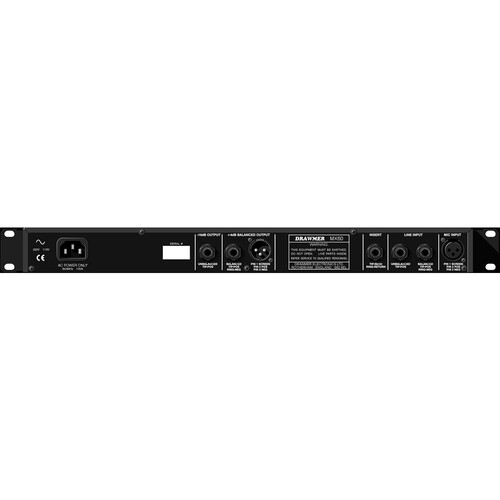The MX60-Pro Front End One from Drawmer is a unique and highly versatile processor designed to act as an all-in-one device for preparing signals for final output to tape, hard disk, or PA systems in project studios and live venues. Combining the functions of a microphone and instrument preamp, DI box, analog VCA compressor, de-esser, parametric equalizer, Program Adaptive gate, and hard limiter, the MX60-Pro can essentially fill the shoes of an entire studio in a single 19" , 1 RU unit.
The MX60-Pro sports lots of I/O options, including XLR and 1/4" inputs and outputs with balanced and unbalanced options, a 1/4" instrument input on the front panel, and a 1/4" auxiliary insert point, making this device highly compatible with a wide range of sources, from low-impedance mics, to keyboard and guitar instruments. The unit also features plenty of useful functions for processing, such as phase reversal, 48V phantom power, adjustable Q control for the EQ section, high- and low-pass filters, a bright boost for instrument inputs, and an innovative Tubesound circuit with 3-band drive, which uses solid-state electronics to emulate the saturation effect of real vacuum tubes. This device utilizes an internal PSU with user-selectable voltage for universal compatibility, and includes an AC power cord for immediate use.
Connections
The MX60 may be used in balanced systems at +4 dBu operating levels, using the XLR or balanced TRS jack output connectors or unbalanced at 10 dBu, using the separate TS jack output. Inputs are provided for balanced low-impedance microphones with switchable 48V phantom power, balanced line at +4 dBu on a TRS jack, or unbalanced line at 10 dBu via an unbalanced TS jack.
A further instrument input is provided on the front panel for use with sources that require a high-impedance input stage, for example, electric guitars and basses. Included only in this section are 20 dB and Bright switches. An insert point is provided directly after the preamp section, followed by phase reverse and high-pass filter switches. A four-section LED meter registers the output level of the preamp stage.
Preamp Section
For use as a front end, the MX60 may be connected directly to the line input of a tape recorder, hard disk recorder, mixer, or other line-level compatible device. However, by using the line input or the insert return as an input, the MX60 may be used in the insert loop of a mixing console to provide dynamic processing, equalization, or Tubesound processing.
In this latter application, ensure that the insert send and return level on your console matches the MX60 input/output sockets that are being used. When setting the input level, observe the level meter and adjust the Gain control, so that the -10 dB LED lights frequently with the 0 dB LED lighting infrequently on signal peaks. If the Clip LED comes on at all, the gain setting should be reduced.
Program Adaptive Gate
The human voice is structurally complex and has a wide dynamic range, which is why the MX60 includes a high-performance dynamics section comprising a gate, a de-esser, and a compressor section. The gate is designed to be easy to set up and silences signals that drop below a minimum level set by the user. Fast and slow release options are included to accommodate all types of material.
VCA Compressor Section
The high-quality VCA compressor reduces the dynamic range of the signal by reducing the gain of loud signals that exceed a threshold set by the user. Both the attack and release times are program adaptive, leaving the user with only ratio, threshold, and make-up gain to adjust. Though simple to set up, the gate section is based on that of the Drawmer DL241/MX30 and, like the compressor, it is program adaptive, so that the time constants are automatically optimized for the material being processed.
De-Esser
Problems can arise when sibilant (S and T) sounds are over-emphasized by a particular singer as they only occur on specific sounds, making it impossible to address them effectively by using a fixed equalizer setting. In some situations, the sibilant sounds may overload some part of the audio chain resulting in an unpleasant distortion. The solution is to use a de-esser, but the Drawmer approach to de-essing is rather more sophisticated than most and the de-esser in the MX60 works on the same principle as that in the MX50 dedicated de-esser where the de-esser automatically and continuously readjusts its own threshold level.
The MX60 de-esser is almost completely automatic requiring the user only to select a male or female setting and to adjust the amount of de-essing taking place. Only that part of the spectrum containing sibilant sounds is subjected to gain reduction so that the lisping effect of simpler de-essers is avoided.
EQ Section
Equalization is provided after compression, so that tonal changes can be made without affecting the compressor action. The MX60 has a powerful three-band equalizer that features shelving high and low sections in conjunction with a fully parametric midrange section.
Tubesound Section
The Tubesound section is based around low-noise, solid-state circuitry designed to emulate the overdrive characteristics of vacuum tubes. Here the signal is split into three frequency bands and each band is provided with a variable drive control.
Increasing the drive level raises both the level and harmonic content of the relevant band, and at low drive settings it's possible to emulate the characteristics of a tube microphone, to add HF enhancement, or to warm up the lower octaves. Higher settings may be used to create more obvious distortion effects on voices or instruments.
Peak Limiter
At the end of the signal path is a fixed threshold limiter, which comes prior to the output level control (Master Fader). The limiter has a fixed preset threshold of +20 dBu and the Master Fader scales the signal level down to the required level.
A hard limit LED indicates the onset of limiting. The soft limit LED indicates a level 6 dB below the main limiter, where progressive rounding of signal peaks occurs prior to the onset of hard limiting.
| Frequency Range | 16 Hz to 28 kHz (-1 dB) |
| Input Impedance | 20 Kilohms |
| Output Impedance | 100 Ohms |
| Maximum Input Level | +21 dBu |
| Maximum Output Level | +20 dBu |
| Input CMRR | >-40 dB (20 Hz to 22 kHz) |
| Noise | Wideband: -85 dB |
| Distortion | <0.05 % (Unity Gain) |
Inputs / Outputs
| Audio I/O | 1x XLR 3-Pin Mic Input 1x 1/4" TRS Line Input (Balanced) 1x 1/4" TS Line Input (Unbalanced) 1x 1/4" TRS Aux Input (Insert) 1x 1/4" TS Hi-Z/Instrument Input (Instrument Input, Front Panel) 1x XLR 3-Pin Line Output (Balanced, +4 dB) 1x 1/4" TRS Line Output (Balanced, +4 dB) 1x 1/4" TS Line Output (Unbalanced, -10 dB) |
Power
| Power Source | AC Input (Built-In) |
| Power Consumption | 15 VA |
| AC Input Power | 115 / 230 VAC, 50/60 Hz (User Selected) |
Environmental
| Certifications | CE |
Physical
| Mounting | Front: 4x Standard Rackmount Hole |
| Color | Black |
| Material of Construction | Metal |
| Dimensions | 19 x 7.9 x 1.7" / 48.2 x 20 x 4.4 cm |
| Weight | 7.1 lb / 3.2 kg |
Packaging Info
| Package Weight | 6.64 lb |
| Box Dimensions (LxWxH) | 22.5 x 14.9 x 4.5" |
In the Box
- Drawmer MX60-Pro Front End One All-In-One Preamp/DI/Gate/EQ/Compressor Unit
- 2-Year Manufacturer Warranty
No posts found












